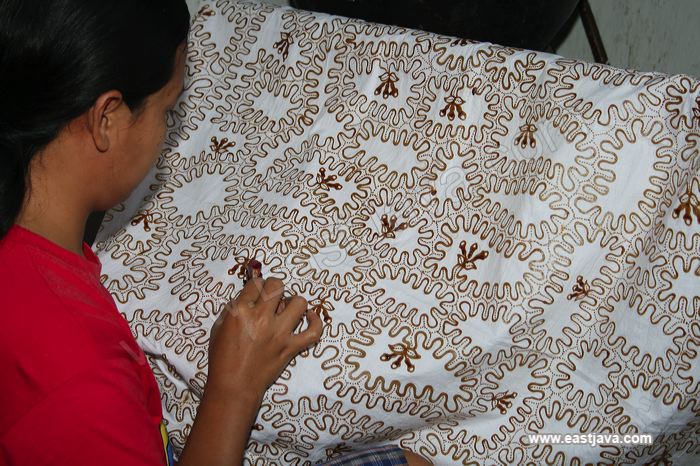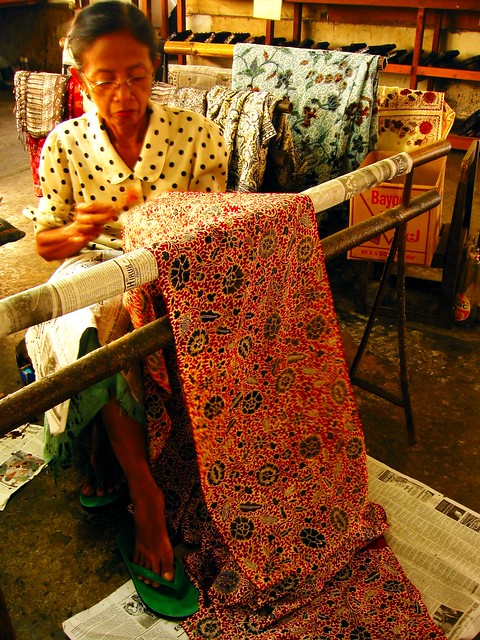
Traditional hand-crafted batik or batik tulis uses cotton or silk. Good quality, densely woven fabrics work best as the wax adheres more closely to the fibres. The material to be used is washed and boiled number of times in water to remove all traces of starch and sizing substances such as lime or chalk. Traditionally the cloth would be pounded or ironed to make it smoother and easier to receive the wax,

although in modern times higher quality machine-made cloth makes this step unnecessary. The cloth is usually white or cream in its original state. The wax used in the batik-making process is commonly a mixture of beeswax and paraffin. Beeswax is used because it is easily shaped without breaking and paraffin cracks easily which creates the desired visual effect. Natural resins are sometimes added to aid adhesiveness,

and animal fats make the wax more liquid. The exact quantity of ingredients for the wax is a closely guarded secret for each individual crafts person. Intricate details of the design are drawn using high quality wax while large areas are filled in with a lower quality cheaper wax. The wax must be kept at the correct temperature: too cold will set in the mouth of the canting tool; and too hot will flow too quickly and be difficult to control.

The wax is heated in a small iron or earthenware wok called a wajan over a charcoal stove or gas burner. While the wax is being applied to the cloth, the remainder is kept in a molten state. The tool used to draw the patterns on the fabric is called a canting or tjanting. This is a small copper container with a long thin spout.

The wax flows down the spout and which is used by the artisan to draw patterns, lines or dots. The canting is attached to a bamboo handle to make it easier to manipulate. A batik maker will usually possess a number of canting with spouts in slightly different sizes. Before applying the wax, the design is drawn lightly on the cloth using charcoal or pencil, or traced from a stencil. Designs are passed down over generations. An individual artisan will have signature designs or may be working to order.

Batik from a particular region often uses the same patterns or motifs, and in Javanese traditional culture, certain designs are reserved for certain stations in life, such as the sultan or royal family. After the design has been sketched out the wax is applied using the canting. The cloth is spread over a bamboo frame to allow the wax to cool and harden easily. The artisan will trace along the pencil outline or apply dots or other patterns.

The spout of the canting does not touch the fabric; it is held just above the material. The pattern is usually waxed on both sides of the cloth. The finest quality batik tulis is truly reversible with an identical pattern on both sides. Great care is taken to not spill any wax on the fabric or otherwise make mistakes as they are virtually impossible to remove. If wax is spilled, the area is soaked in hot water and then the wax is peeled off with a sharp knife.

However, spilled wax can rarely be completely removed without any spoilage which reduces the price of the finished cloth. Therefore, detailed work is usually performed by the most experienced artisan. Large areas are often filled in by less experienced apprentices. When the design has been completed, the cloth is dyed in earthenware or concrete vats of dye. The amount time it is immersed in the vat affects how dark the color will be.

After dyeing, the fabric is dried and further coats of wax applied if the artisan wants to add further colors with another dyeing process. A marble effect can be created by deliberately cracking the wax before immersion in the dye. The number of colors on a piece of batik shows how many times it was dyed and wax re-applied, and a higher number is reflected in a higher price for the finished piece.

Traditionally colors were restricted to those from natural dyes but nowadays chemical dyes are used for a much greater range. After all the required colors have been applied, the finished batik is soaked in a solvent to dissolve the remaining wax, or ironed between sheets of paper which absorbs the wax. Some batik for special occasions was decorated with gold dust or gold leaf.

The gold was painted on to the finished cloth using a glue made from egg white and oil. The gold was often used to highlight aspects of the design. Gold is still used today, but often in the form of paint. Traditional hand-drawn batik is very time-consuming and costly to produce so at the end of the 19th century, a method of batik production was developed that greatly speeded up the process. Wax is used to coat a copper stamp called a cap which is then pressed onto the cloth.

The process is repeated until the entire surface has been filled. This method is very effective for repetitive designs but is often combined with detail added by the canting. Great care must be taken to align the edges of the stamped design in order to reproduce the pattern exactly. On lower quality, cheaper batik produced using the cap, overlapping lines can sometimes be seen.

Hannd-drawn batik produced by the traditional methods and cap batik is still widely available across Asia.

However,the majority of batik fabric and clothes is made using factory produced batik print: cloth printed with the traditional designs and colors but without the application of wax. Many of these factories and designers use computers to produce accurate repetitive patterns. On a smaller scale, some contemporary batik designers and painters using batik as a medium are producing designs and using materials that move away from the formal and traditional styles of their ancestors whilst maintaining the feel and elegance of the original concept.
 Traditional hand-crafted batik or batik tulis uses cotton or silk. Good quality, densely woven fabrics work best as the wax adheres more closely to the fibres. The material to be used is washed and boiled number of times in water to remove all traces of starch and sizing substances such as lime or chalk. Traditionally the cloth would be pounded or ironed to make it smoother and easier to receive the wax,
Traditional hand-crafted batik or batik tulis uses cotton or silk. Good quality, densely woven fabrics work best as the wax adheres more closely to the fibres. The material to be used is washed and boiled number of times in water to remove all traces of starch and sizing substances such as lime or chalk. Traditionally the cloth would be pounded or ironed to make it smoother and easier to receive the wax,  although in modern times higher quality machine-made cloth makes this step unnecessary. The cloth is usually white or cream in its original state. The wax used in the batik-making process is commonly a mixture of beeswax and paraffin. Beeswax is used because it is easily shaped without breaking and paraffin cracks easily which creates the desired visual effect. Natural resins are sometimes added to aid adhesiveness,
although in modern times higher quality machine-made cloth makes this step unnecessary. The cloth is usually white or cream in its original state. The wax used in the batik-making process is commonly a mixture of beeswax and paraffin. Beeswax is used because it is easily shaped without breaking and paraffin cracks easily which creates the desired visual effect. Natural resins are sometimes added to aid adhesiveness,  and animal fats make the wax more liquid. The exact quantity of ingredients for the wax is a closely guarded secret for each individual crafts person. Intricate details of the design are drawn using high quality wax while large areas are filled in with a lower quality cheaper wax. The wax must be kept at the correct temperature: too cold will set in the mouth of the canting tool; and too hot will flow too quickly and be difficult to control.
and animal fats make the wax more liquid. The exact quantity of ingredients for the wax is a closely guarded secret for each individual crafts person. Intricate details of the design are drawn using high quality wax while large areas are filled in with a lower quality cheaper wax. The wax must be kept at the correct temperature: too cold will set in the mouth of the canting tool; and too hot will flow too quickly and be difficult to control.  The wax is heated in a small iron or earthenware wok called a wajan over a charcoal stove or gas burner. While the wax is being applied to the cloth, the remainder is kept in a molten state. The tool used to draw the patterns on the fabric is called a canting or tjanting. This is a small copper container with a long thin spout.
The wax is heated in a small iron or earthenware wok called a wajan over a charcoal stove or gas burner. While the wax is being applied to the cloth, the remainder is kept in a molten state. The tool used to draw the patterns on the fabric is called a canting or tjanting. This is a small copper container with a long thin spout.  The wax flows down the spout and which is used by the artisan to draw patterns, lines or dots. The canting is attached to a bamboo handle to make it easier to manipulate. A batik maker will usually possess a number of canting with spouts in slightly different sizes. Before applying the wax, the design is drawn lightly on the cloth using charcoal or pencil, or traced from a stencil. Designs are passed down over generations. An individual artisan will have signature designs or may be working to order.
The wax flows down the spout and which is used by the artisan to draw patterns, lines or dots. The canting is attached to a bamboo handle to make it easier to manipulate. A batik maker will usually possess a number of canting with spouts in slightly different sizes. Before applying the wax, the design is drawn lightly on the cloth using charcoal or pencil, or traced from a stencil. Designs are passed down over generations. An individual artisan will have signature designs or may be working to order.  Batik from a particular region often uses the same patterns or motifs, and in Javanese traditional culture, certain designs are reserved for certain stations in life, such as the sultan or royal family. After the design has been sketched out the wax is applied using the canting. The cloth is spread over a bamboo frame to allow the wax to cool and harden easily. The artisan will trace along the pencil outline or apply dots or other patterns.
Batik from a particular region often uses the same patterns or motifs, and in Javanese traditional culture, certain designs are reserved for certain stations in life, such as the sultan or royal family. After the design has been sketched out the wax is applied using the canting. The cloth is spread over a bamboo frame to allow the wax to cool and harden easily. The artisan will trace along the pencil outline or apply dots or other patterns.  The spout of the canting does not touch the fabric; it is held just above the material. The pattern is usually waxed on both sides of the cloth. The finest quality batik tulis is truly reversible with an identical pattern on both sides. Great care is taken to not spill any wax on the fabric or otherwise make mistakes as they are virtually impossible to remove. If wax is spilled, the area is soaked in hot water and then the wax is peeled off with a sharp knife.
The spout of the canting does not touch the fabric; it is held just above the material. The pattern is usually waxed on both sides of the cloth. The finest quality batik tulis is truly reversible with an identical pattern on both sides. Great care is taken to not spill any wax on the fabric or otherwise make mistakes as they are virtually impossible to remove. If wax is spilled, the area is soaked in hot water and then the wax is peeled off with a sharp knife.  However, spilled wax can rarely be completely removed without any spoilage which reduces the price of the finished cloth. Therefore, detailed work is usually performed by the most experienced artisan. Large areas are often filled in by less experienced apprentices. When the design has been completed, the cloth is dyed in earthenware or concrete vats of dye. The amount time it is immersed in the vat affects how dark the color will be.
However, spilled wax can rarely be completely removed without any spoilage which reduces the price of the finished cloth. Therefore, detailed work is usually performed by the most experienced artisan. Large areas are often filled in by less experienced apprentices. When the design has been completed, the cloth is dyed in earthenware or concrete vats of dye. The amount time it is immersed in the vat affects how dark the color will be.  After dyeing, the fabric is dried and further coats of wax applied if the artisan wants to add further colors with another dyeing process. A marble effect can be created by deliberately cracking the wax before immersion in the dye. The number of colors on a piece of batik shows how many times it was dyed and wax re-applied, and a higher number is reflected in a higher price for the finished piece.
After dyeing, the fabric is dried and further coats of wax applied if the artisan wants to add further colors with another dyeing process. A marble effect can be created by deliberately cracking the wax before immersion in the dye. The number of colors on a piece of batik shows how many times it was dyed and wax re-applied, and a higher number is reflected in a higher price for the finished piece.  Traditionally colors were restricted to those from natural dyes but nowadays chemical dyes are used for a much greater range. After all the required colors have been applied, the finished batik is soaked in a solvent to dissolve the remaining wax, or ironed between sheets of paper which absorbs the wax. Some batik for special occasions was decorated with gold dust or gold leaf.
Traditionally colors were restricted to those from natural dyes but nowadays chemical dyes are used for a much greater range. After all the required colors have been applied, the finished batik is soaked in a solvent to dissolve the remaining wax, or ironed between sheets of paper which absorbs the wax. Some batik for special occasions was decorated with gold dust or gold leaf.  The process is repeated until the entire surface has been filled. This method is very effective for repetitive designs but is often combined with detail added by the canting. Great care must be taken to align the edges of the stamped design in order to reproduce the pattern exactly. On lower quality, cheaper batik produced using the cap, overlapping lines can sometimes be seen.
The process is repeated until the entire surface has been filled. This method is very effective for repetitive designs but is often combined with detail added by the canting. Great care must be taken to align the edges of the stamped design in order to reproduce the pattern exactly. On lower quality, cheaper batik produced using the cap, overlapping lines can sometimes be seen.  Hannd-drawn batik produced by the traditional methods and cap batik is still widely available across Asia.
Hannd-drawn batik produced by the traditional methods and cap batik is still widely available across Asia.  However,the majority of batik fabric and clothes is made using factory produced batik print: cloth printed with the traditional designs and colors but without the application of wax. Many of these factories and designers use computers to produce accurate repetitive patterns. On a smaller scale, some contemporary batik designers and painters using batik as a medium are producing designs and using materials that move away from the formal and traditional styles of their ancestors whilst maintaining the feel and elegance of the original concept.
However,the majority of batik fabric and clothes is made using factory produced batik print: cloth printed with the traditional designs and colors but without the application of wax. Many of these factories and designers use computers to produce accurate repetitive patterns. On a smaller scale, some contemporary batik designers and painters using batik as a medium are producing designs and using materials that move away from the formal and traditional styles of their ancestors whilst maintaining the feel and elegance of the original concept.










